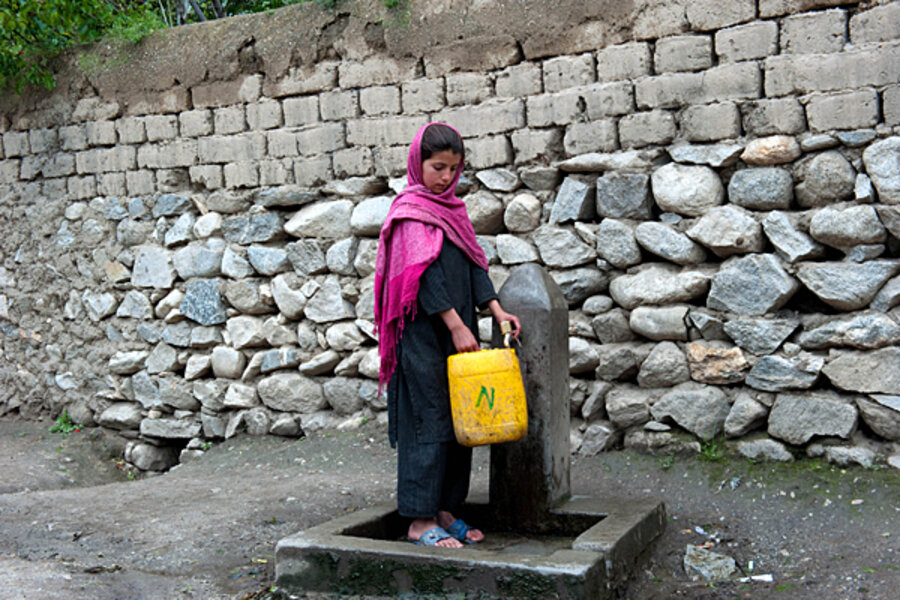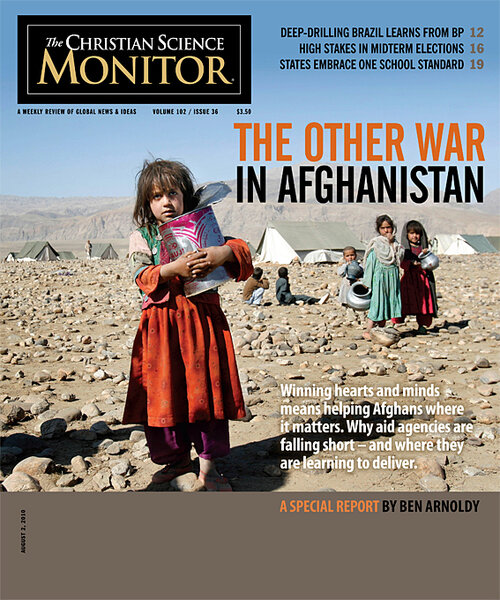Afghanistan war: USAID spends too much, too fast to win hearts and minds
Loading...
| Kabul, Afghanistan
The US government strategy for improving its struggling reconstruction efforts in Afghanistan relies heavily on spending more money. More on bigger and quicker projects, more on aid workers, and more on monitors – a "civilian surge" to win hearts and minds.
That should be welcome news to development professionals who have spent careers toiling in ravaged regions with only band-aid budgets.
But in Afghanistan, some aid workers actually argue that the aid flow has become a desperate gambit – throwing too much money with too little thought at the problem. They say that perhaps less money is more.
Even consultants hired by the US Agency for International Development (USAID) to evaluate its Afghan projects drop such hints. Tucked near the bottom of a new report on a four-year, $60 million aid project in the remote northern province of Badakhshan (detailed in the Monitor's investigative piece "How USAID loses hearts and minds") lies the argument in almost haiku precision: "It would have been better to do less, but endow what was done with more staying power."
That's not the message USAID is getting from above, however. With a 2011 deadline for a troop drawdown, US military strategy is putting a lot of pressure on the agency – the biggest reconstruction actor in the country – to show more quick impact to help pacify the insurgency in time.
Related: How USAID lost hearts and minds in Afghanistan
A firehose of spending has been unleashed: Through an account called the Economic Support Fund, US spending on Afghan development rose from $1.4 billion in 2008 to roughly $2 billion in 2009 and in 2010, and President Obama is requesting it jump to $5 billion in 2011. Some in Congress are starting to balk, questioning any more aid until Afghan corruption can be curbed.
Among the skeptics of the surge is Andrew Wilder, a professor at Tufts University in Medford, Mass., who has conducted fieldwork in southern Afghanistan. His research questions the whole notion that development will win over Afghan hearts and minds and contribute to stability.
"The main drivers of instability in southern Afghanistan are not largely related to poverty or lack of reconstruction or social services," says Mr. Wilder. Instead, corrupt government is a large part of the problem.
But, the current thinking that lack of development is an irritant has the United States spending what Wilder calls a "tsunami of cash" – a response that may actually be making things worse.
The danger is that large amounts fuel perceptions of waste and corruption among Afghans when projects don't live up to the price tags. The big budgets also scare off experienced nonprofits that don't want to jeopardize quality by scaling up too quickly.
"We should do as much as we can effectively and accountably, and no more. When we start spending money unaccountably, then it's having a lot of negative consequences, including perceptions of corruption. That then delegitimizes the government, which causes instability," says Wilder.
• • •
Spending larger sums of money through USAID diminishes the quality of assistance in several ways, argue critics.
Those who implement USAID projects report an increasing focus on "burn rates" – a measure of how quickly money is spent. Emphasis is put on spending fast to make room for the next tranche from Congress. "It's not that there is too much money, it's that it's all spent at one time. There is no absorption capacity," says Lorenzo Delesgues, director of Integrity Watch Afghanistan in Kabul.
Or, as James Graham, the former country director of the four-year Badakhshan contract puts it: "Part of the problem is when you were working in the 11th century, what is the capacity of the 11th century to absorb the 60 million bucks? Especially when there are people who are looking to put a lot of that in their own pocket."
In the case of the Badakhshan project, burn rates accelerated in the final year (2009) as the contractor tried to unload the 40 percent of the budget that was unspent. Some went to shoddy paving and power canal construction, some to heavy equipment, and some to last-minute handouts.
Staying within absorption limits is "Development 101," says Mr. Delesgues, "but here you are fighting with the calendars of Congress."
Many of the aid groups that have worked the longest in Afghanistan, like the Swedish Committee and CARE, know this and avoid bidding on USAID jobs. That's left USAID with nowhere to turn but for-profit contractors happy to take the money.
The aid community here is rife with tales of big-contract waste such as:
•A project that flew a team of expert cobblestone-road builders to Helmand Province from Bolivia to build a tourist road instead of just using gravel. Mr. Graham says USAID pushed – unsuccessfully – for cobblestone roads up in Badakhshan as well, despite the region's frost heaving.
•A bridge built by an international contractor near Jalalabad that washed away after the contractor failed to take into account the springtime swelling of the river.
•A massive new turbine for the Kajaki dam that remains unused after NATO diverted thousands of coalition troops to escort it through enemy territory in Helmand. It's too dangerous to bring the cement to install it.
•Three girls' schools built by the international community all within miles of Bagram. The mayor says one is attended only by a bored security guard, pigeons, and squirrels.
•The 40 criminal cases – including contract fraud and bribery – being pursued by the Special Inspector General for Afghanistan Reconstruction (SIGAR), which has recently recovered more than $2 million from contractors.
"Many of the NGOs could do a far better job, but there is no way that we can responsibly deal with contracts worth $300 [million] to $400 million," says Lex Kassenberg, Afghan country director of CARE International. "Yet somehow a lot of these consultancies are given the jobs even when not qualified."
• • •
The BadakHshan contract wound up with PADCO, a US firm that had no prior experience in Afghanistan, after more experienced nonprofits like the Aga Khan Development Network shied away. The AKDN has been working on a lot of projects for the National Solidarity Program (NSP), an Afghan government program funded by international donors, including the US, that has spent $1 billion bringing bottom-up development to 70 percent of Afghan villages.
The for-profit model like that of the Badakhshan project relies on satisfying contract terms and moving to the next contract. Without the trust of long-term relationships, many firms spend up to a third of a contract on security.
USAID officials and other aid experts say the answer isn't to scale back spending but to upgrade the agency staffing to handle it better.
During the cold war, Washington funded USAID to compete with the Soviet Union in winning foreign friends. With the Soviet collapse, Washington gutted USAID, forcing out many technical experts who'd spent time in the field. The agency became dominated by contract managers with little institutional memory. Between 1995 and 2007, 45 percent of the Foreign Service officer corps reached retirement age. And this decade, USAID tackled Iraq and Afghan reconstruction without new staffing.
"Until the Obama administration, USAID's personnel and authority had been systematically diminishing over time," says Paul O'Brien, vice president of policy at Oxfam America. While internal USAID protocols recommend each manager oversee roughly $10 million in grants, in Afghanistan the number was topping $100 million, he says.
A "civilian surge" beginning last fall increased the number of American USAID officers in Afghanistan from 90 to 270. USAID says the amount of money each officer is overseeing has stabilized or decreased. With the added staff and its wider footprint, USAID is confident the agency can manage the money.
"We have US private firms and US private volunteer firms who have shown they can handle [the money] responsibly," says James Bever, USAID's Afghan and Pakistan operations chief. "Yes, sometimes there are problems – and [inspectors] have picked up on those cases."
Though USAID says the adjustment allows more staff to get out of Kabul and into the field, one of the government employees deployed as part of the surge says many of his colleagues outside Kabul still are trapped on bases due to security restrictions. And they end up overseeing cash-for-work programs that don't require agricultural or engineering expertise.
• • •
One inspector charged with finding problems says it's too soon to know how much the civilian surge has helped.
But, says John Brummet, a top auditor with SIGAR, "more attention is needed on increasing the capacity of the Afghan institutions to help deal with this. We should strengthen those offices because they can play a role in bringing more accountability and hopefully bringing less corruption to these large sums of money."
A successful example of that is the $1 billion spent on the NSP. The money is carved up into chunks of $30,000 or so and given to villages to spend on projects of their choice, with locally elected leaders held accountable by their neighbors.
USAID says the agency is working to rely less on large international contractors and more on building Afghan institutional capacity, but transition time is required. USAID is channeling more money through the Afghan government to fund programs like the NSP. But the big pieces of Afghanistan's infrastructure skeleton can't be tackled by small-scale nongovernmental organizations and bottom-up approaches like the NSP, says Mr. O'Brien of Oxfam. Big projects should still be attempted, but with more involvement from pockets of competence in the Afghan government. "What happens in Afghanistan may end up shaping the broader development agenda," says O'Brien. "It would be a real tragedy if the outcome of the Afghanistan story is that money just can't be spent responsibly."
• Correspondent Edward Girardet contributed to this report.
Related:






